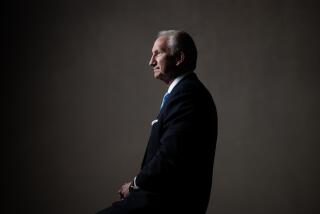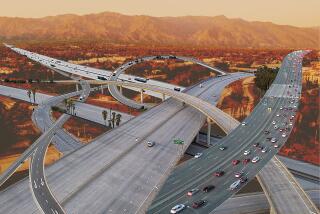UPS has found ways to work in traffic
- Share via
Los Angeles has some of the most congested streets and highways in the nation, but Gil Cordova, a veteran driver for United Parcel Service, is rarely stuck in traffic.
The country’s largest delivery company plans it that way.
The shortest, most efficient route for his deliveries is plotted by computer. UPS tries to strategically locate its buildings so drivers can travel against traffic. Routes are planned to avoid left turns. Even the brisk pace of Cordova’s walk -- six steps in three seconds -- is the product of the company’s industrial engineers.
“I don’t stop when I’m on the job,” Cordova said one morning as he steered his chocolate-brown truck down Sunset Boulevard in Hollywood.
“All the planning we do keeps me moving,” he said.
Cordova works out of the UPS center at 1800 N. Main St., northeast of the Los Angeles Civic Center. The facility handles about 60,000 packages a day and employs about 275 drivers.
All UPS deliveries are planned with the help of a $600-million computer system that was implemented about two years ago. Unique in the shipping industry, it represents state-of-the-art trip planning, an idea touted by transportation experts as a way to cope with increasingly congested urban areas.
To design the most efficient routes, the computer program avoids hills, dead-end streets and railroad tracks. It weeds out busy thoroughfares and streets with many signals.
All the information about Cordova’s daily route is fed into a hand-held computer. The device lists more than 200 carefully sequenced deliveries. It shows Cordova where to park and the most convenient entrances to buildings. A global positioning system in the computer even beeps if Cordova arrives at the wrong address.
Transportation researchers expect that one day most commuters will have access to the kind of technology UPS uses. Drivers will be able to get real-time traffic data from in-car computers. Planners also foresee other high-tech gadgets, including proximity sensors that will warn drivers if they’re getting too close to other cars.
“I used to be old-school, relying on my memory and experience,” said Cordova, who has worked 24 years for UPS. “I thought all this computerization wasn’t going to work. Now I know it does.”
Computer planning has cut the miles he travels daily from 40 to 32, he said. At the Los Angeles facility alone, UPS estimates that the number of total miles traveled by drivers has been reduced from 12,000 to about 11,000 a day.
When on his route, Cordova wastes almost no time. He is either driving, getting packages ready or delivering them.
“You can’t waste time in this business,” Cordova said. “If you have 120 stops a day and waste a minute for each, that’s two hours of delay. You’ll never get done.”
--
dan.weikel@latimes.com
More to Read
Inside the business of entertainment
The Wide Shot brings you news, analysis and insights on everything from streaming wars to production — and what it all means for the future.
You may occasionally receive promotional content from the Los Angeles Times.










